From Efficiency to Circularity in the Wastewater Sector: A Review of Performance Indicators in Regulated Countries
Abstract
1. Introduction
2. Methods
3. Results and Discussion
4. Conclusions
Supplementary Materials
Author Contributions
Funding
Data Availability Statement
Acknowledgments
Conflicts of Interest
Abbreviations
| CE | Circular Economy |
| WWTP | Wastewater Treatment Plants |
| KPI | Key Performance Indicator |
| CEAP | Circular Economy Action Plan |
| WRRF | Water Resource Recovery Facilities |
| PRISMA | Preferred Reporting Items for Systematic Reviews and Meta-Analyses |
| OECD | Organisation for Economic Co-operation and Development |
| WAREG | Association of European Regulators in the drinking water and wastewater sector |
| IWA | International Water Association |
| IBNET | International Benchmarking Network for Water and Sanitation Utilities |
| UN SDG | United Nations Sustainable Development Goals |
| NGO | Non-Governmental Organization |
| UWWTD | Urban Wastewater Treatment Directive |
References
- Biswas, A.; Biswas, S. Circular Economy in Urban Wastewater Management: A Concise Review. In Circular Economy: Applications for Water Remediation; Shah, P., Manna, S., Das, P., Eds.; CRC Press: Boca Raton, FL, USA, 2024; pp. 153–169. [Google Scholar] [CrossRef]
- Santos, E.; Lisboa, I.; Eugénio, T. Economic Sustainability in Wastewater Treatment Companies: A Regional Analysis for the Iberian Peninsula. Appl. Sci. 2021, 11, 9876. [Google Scholar] [CrossRef]
- Smol, M.; Adam, C.; Preisner, M. Circular economy model framework in the European water and wastewater sector. J. Mater. Cycles Waste Manag. 2020, 22, 682–697. [Google Scholar] [CrossRef]
- Mannina, G.; Alduina, R.; Badalucco, L.; Barbara, L.; Capri, F.C.; Cosenza, A.; di Trapani, D.; Gallo, G.; Laudicina, V.A.; Muscarella, S.M.; et al. Water Resource Recovery Facilities (WRRFs): The Case Study of Palermo University (Italy). Water 2021, 13, 3413. [Google Scholar] [CrossRef]
- Smol, M. Circular Economy in Wastewater Treatment Plant—Water, Energy and Raw Materials Recovery. Energies 2023, 16, 3911. [Google Scholar] [CrossRef]
- Tarpani, R.R.Z.; Azapagic, A. Life cycle sustainability assessment of advanced treatment techniques for urban wastewater reuse and sewage sludge resource recovery. Sci. Total Environ. 2023, 869, 161771. [Google Scholar] [CrossRef] [PubMed]
- Patwa, N.; Sivarajah, U.; Seetharaman, A.; Sarkar, S.; Maiti, K.; Hingorani, K. Towards a circular economy: An emerging economies context. J. Bus. Res. 2021, 122, 725–735. [Google Scholar] [CrossRef]
- Murray, A.; Skene, K.; Haynes, K. The Circular Economy: An Interdisciplinary Exploration of the Concept and Application in a Global Context. J. Bus. Ethics 2017, 140, 369–380. [Google Scholar] [CrossRef]
- Hartley, K.; van Santen, R.; Kirchherr, J. Policies for transitioning towards a circular economy: Expectations from the European Union (EU). Resour. Conserv. Recycl. 2020, 155, 104634. [Google Scholar] [CrossRef]
- Alegre, H.; Baptista, J.M.; Cabrera, E.; Cubillo, F.; Duarte, P.; Hirner, W.; Merkel, W.; Parena, R. Performance Indicators for Water Supply Services: Third Edition. Water Intell. Online 2016, 15, 9781780406336. [Google Scholar] [CrossRef]
- Velenturf, A.P.M.; Purnell, P. Principles for a sustainable circular economy. In Sustainable Production and Consumption; Elsevier B.V.: Amsterdam, The Netherlands, 2021; Volume 27, pp. 1437–1457. [Google Scholar] [CrossRef]
- Neczaj, E.; Grosser, A. Circular Economy in Wastewater Treatment Plant–Challenges and Barriers. Proceedings 2018, 2, 614. [Google Scholar] [CrossRef]
- Moraga, G.; Huysveld, S.; Mathieux, F.; Blengini, G.A.; Alaerts, L.; Van Acker, K.; de Meester, S.; Dewulf, J. Circular economy indicators: What do they measure? Resour. Conserv. Recycl. 2019, 146, 452–461. [Google Scholar] [CrossRef]
- Ferasso, M.; Beliaeva, T.; Kraus, S.; Clauss, T.; Ribeiro-Soriano, D. Circular economy business models: The state of research and avenues ahead. Bus. Strategy Environ. 2020, 29, 3006–3024. [Google Scholar] [CrossRef]
- Mannina, G.; Badalucco, L.; Barbara, L.; Cosenza, A.; di Trapani, D.; Gallo, G.; Laudicina, V.A.; Marino, G.; Muscarella, S.M.; Presti, D.; et al. Enhancing a Transition to a Circular Economy in the Water Sector: The EU Project WIDER UPTAKE. Water 2021, 13, 946. [Google Scholar] [CrossRef]
- Shanmugam, K.; Gadhamshetty, V.; Tysklind, M.; Bhattacharyya, D.; Upadhyayula, V.K.K. A sustainable performance assessment framework for circular management of municipal wastewater treatment plants. J. Clean. Prod. 2022, 339, 130657. [Google Scholar] [CrossRef]
- Morseletto, P. Targets for a circular economy. Resour. Conserv. Recycl. 2020, 153, 104553. [Google Scholar] [CrossRef]
- European Commission. Closing the Loop—An EU Action Plan for the Circular Economy. 2015. Available online: https://eur-lex.europa.eu/resource.html?uri=cellar:8a8ef5e8-99a0-11e5-b3b7-01aa75ed71a1.0012.02/DOC_1&format=PDF (accessed on 22 April 2025).
- Kalemba, K. Circular Economy in Wastewater Treatment Plant. Archit. Civ. Eng. Environ. 2020, 13, 93–97. [Google Scholar] [CrossRef]
- European Commission. A New Circular Economy Action Plan. 2020. Available online: https://eur-lex.europa.eu/resource.html?uri=cellar:9903b325-6388-11ea-b735-01aa75ed71a1.0017.02/DOC_1&format=PDF (accessed on 24 April 2025).
- Nika, C.E.; Vasilaki, V.; Expósito, A.; Katsou, E. Water Cycle and Circular Economy: Developing a Circularity Assessment Framework for Complex Water Systems. Water Res. 2020, 187, 116423. [Google Scholar] [CrossRef]
- Smol, M.; Koneczna, R. Economic Indicators in Water and Wastewater Sector Contributing to a Circular Economy (CE). Resources 2021, 10, 129. [Google Scholar] [CrossRef]
- Evans, B.; Khoury, M.; Vamvakeridou-Lyroudia, L.; Chen, O.; Mustafee, N.; Chen, A.; Djordjevic, S.; Savic, D. A modelling testbed to demonstrate the circular economy of water. J. Clean. Prod. 2023, 405, 137018. [Google Scholar] [CrossRef]
- Furness, M.F.; Bello-Mendoza, R.; Güereca, L.P.; Chamy Maggi, R. The biofactories: Quantifying environmental benefits of the wastewater circular economy in Chile using life cycle assessment. Circ. Econ. 2024, 3, 100091. [Google Scholar] [CrossRef]
- Hernández-Chover, V.; Castellet-Viciano, L.; Bellver-Domingo, Á.; Hernández-Sancho, F. The Potential of Digitalization to Promote a Circular Economy in the Water Sector. Water 2022, 14, 3722. [Google Scholar] [CrossRef]
- Preisner, M.; Smol, M.; Horttanainen, M.; Deviatkin, I.; Havukainen, J.; Klavins, M.; Ozola-Davidane, R.; Kruopienė, J.; Szatkowska, B.; Appels, L.; et al. Indicators for resource recovery monitoring within the circular economy model implementation in the wastewater sector. J. Environ. Manag. 2022, 304, 114261. [Google Scholar] [CrossRef] [PubMed]
- Almeida, M.; Mannina, G.; Badalucco, L.; Barbara, L.; Cosenza, A.; di Trapani, D.; Laudicina, V.A.; Muscarella, S.M.; Presti, D. Roadmapping the Transition to Water Resource Recovery Facilities: The Two Demonstration Case Studies of Corleone and Marineo (Italy). Water 2022, 14, 156. [Google Scholar] [CrossRef]
- Soo, A.; Kim, J.; Shon, H.K. Technologies for the wastewater circular economy—A review. Desalinat. Water Treat. 2025, 317, 100205. [Google Scholar] [CrossRef]
- Guerra-Rodríguez, S.; Oulego, P.; Rodríguez, E.; Singh, D.N.; Rodríguez-Chueca, J. Towards the Implementation of Circular Economy in the Wastewater Sector: Challenges and Opportunities. Water 2020, 12, 1431. [Google Scholar] [CrossRef]
- Kathi, S.; Singh, S.; Yadav, R.; Singh, A.N.; Mahmoud, A.E.D. Wastewater and sludge valorisation: A novel approach for treatment and resource recovery to achieve circular economy concept. Front. Chem. Eng. 2023, 5, 1129783. [Google Scholar] [CrossRef]
- Arora, M.; Yeow, L.W.; Cheah, L.; Derrible, S. Assessing water circularity in cities: Methodological framework with a case study. Resour. Conserv. Recycl. 2022, 178, 106042. [Google Scholar] [CrossRef]
- Estévez, S.; Arias, A.; Feijoo, G.; Moreira, M.T. Methodological guide and roadmap to assess the compliance of wastewater treatment plants with sustainability and circularity criteria. Water Res. 2025, 274, 123125. [Google Scholar] [CrossRef]
- Renfrew, D.; Vasilaki, V.; Nika, E.; Tsalidis, G.A.; Marin, E.; Katsou, E. Systematic assessment of wastewater resource circularity and sustainable value creation. Water Res. 2024, 251, 121141. [Google Scholar] [CrossRef]
- Page, M.J.; McKenzie, J.E.; Bossuyt, P.M.; Boutron, I.; Hoffmann, T.C.; Mulrow, C.D.; Shamseer, L.; Tetzlaff, J.M.; Akl, E.A.; Brennan, S.E.; et al. The PRISMA 2020 statement: An updated guideline for reporting systematic reviews. BMJ 2021, 372, n71. [Google Scholar] [CrossRef]
- OECD. OECD Water Governance Indicator Framework; OECD: Paris, France, 2018. [Google Scholar] [CrossRef]
- WAREG an Analysis of Water Efficiency KPIS in WAREG Member Countries. 2017. Available online: https://www.wareg.org/documents/an-analysis-of-water-efficiency-kpis-in-wareg-member-countries/ (accessed on 22 April 2025).
- WAREG Key Performance Indicators Frameworks in Wareg Member Countries. 2023. Available online: https://www.wareg.org/documents/kpis-report-2023-wareg-pdf/ (accessed on 22 April 2025).
- Danilenko, A.; van den Berg, C.; Macheve, B.; Moffitt, L.J. The IBNET Water Supply and Sanitation Blue Book 2014: The International Benchmarking Network for Water and Sanitation Utilities Databook; The World Bank: Washington, DC, USA, 2014. [Google Scholar] [CrossRef]
- Matos, R.; Cardoso, A.; Ashley, R.; Duarte, P.; Molinari, A.; Schulz, A. Performance Indicators for Wastewater Services. Water Intell. Online 2005, 4, 9781780402796. [Google Scholar] [CrossRef]
- Rodrigues, S.; Costa, A.; Cardoso, J.; Rodrigues, R.; Maria Adriana Cardoso João Rosa, M.; Salgado Brito, R.; Silva, C.; Beceiro, P.; Jorge, C.; Alegre, H.; et al. Guide for Assessment of the quality of Water and Waste Services Provided to Users—4th Generation Assessment System, 4th ed.; ERSAR: Lisboa, Portugal, 2023. [Google Scholar]
- Renfrew, D.; Vasilaki, V.; Nika, E.; Harris, E.; Katsou, E. Tracing wastewater resources: Unravelling the circularity of waste using source, destination, and quality analysis. Water Res. 2024, 250, 120901. [Google Scholar] [CrossRef]
- Rodrigues, C.; Martins, T.A.E.; Amaral, L. Wastewater treatment plants circular performance models evaluation: Portugal case-study. Sci. Total Environ. 2024, 955, 177013. [Google Scholar] [CrossRef]
- Salvetti, M.; Sideris, K. Economic Regulators’ Role in Supporting the Ecological Transition of Water and Sanitation Service Operators; European University Institute (EUI): San Domenico di Fiesole, Italy, 2022. [Google Scholar]
- Ribarova, I.; Vasilaki, V.; Katsou, E. Review of linear and circular approaches to on-site domestic wastewater treatment: Analysis of research achievements, trends and distance to target. J. Environ. Manag. 2024, 367, 121951. [Google Scholar] [CrossRef]
- Ren, J.; Liang, H. Multi-criteria group decision-making based sustainability measurement of wastewater treatment processes. Environ. Impact Assess. Rev. 2017, 65, 91–99. [Google Scholar] [CrossRef]
- Kirchherr, J.; Reike, D.; Hekkert, M. Conceptualizing the circular economy: An analysis of 114 definitions. Resour. Conserv. Recycl. 2017, 127, 221–232. [Google Scholar] [CrossRef]
- Liu, Q.; Yang, L.; Yang, M. Digitalisation for water sustainability: Barriers to implementing circular economy in smart water management. Sustainability 2021, 13, 11868. [Google Scholar] [CrossRef]
- Areosa, I.; Martins, T.A.E.; Lourinho, R.; Batista, M.; Brito, A.G.; Amaral, L. Treated wastewater reuse for irrigation: A feasibility study in Portugal. Sci. Total Environ. 2024, 954, 176698. [Google Scholar] [CrossRef]
- Zaidi, M.; Ahfir, N.D.; Alem, A.; el Mansouri, B.; Wang, H.; Taibi, S.; Duchemin, B.; Merzouk, A. Assessment of clogging of managed aquifer recharge in a semi-arid region. Sci. Total Environ. 2020, 730, 139107. [Google Scholar] [CrossRef]
- Chrispim, M.C.; de Souza Fde, M.; Scholz, M.; Nolasco, M.A. A framework for sustainable planning and decision-making on resource recovery from wastewater: Showcase for São Paulo megacity. Water 2020, 12, 3466. [Google Scholar] [CrossRef]
- Cossio, C.; Norrman, J.; McConville, J.; Mercado, A.; Rauch, S. Indicators for sustainability assessment of small-scale wastewater treatment plants in low and lower-middle income countries. Environ. Sustain. Indic. 2020, 6, 100028. [Google Scholar] [CrossRef]
- El Moussaoui, T.; Belloulid, M.O.; Elharbili, R.; el Ass, K.; Ouazzani, N. Simultaneous assessment of purification performances and wastewater byproducts management plans towards a circular economy: Case of Marrakesh WWTP. Case Stud. Chem. Environ. Eng. 2022, 6, 100228. [Google Scholar] [CrossRef]
- Essex, B.; Koop, S.H.A.; van Leeuwen, C.J. Proposal for a National Blueprint Framework to Monitor Progress on Water-Related Sustainable Development Goals in Europe. Environ. Manag. 2020, 65, 1–18. [Google Scholar] [CrossRef]
- Heshmati, A.; Rashidghalam, M. Assessment of the urban circular economy in Sweden. J. Clean. Prod. 2021, 310, 127475. [Google Scholar] [CrossRef]
- Kacprzak, M.J.; Kupich, I. The specificities of the circular economy (CE) in the municipal wastewater and sewage sludge sector—Local circumstances in Poland. Clean Technol. Environ. Policy 2023, 25, 519–535. [Google Scholar] [CrossRef]
- Marami, H.; He, L.; Rafiee, S.; Khoshnevisan, B.; Tsapekos, P.; Mobli, H.; Elyasi, S.N.; Liu, H.; Angelidaki, I. Bridging to circular bioeconomy through a novel biorefinery platform on a wastewater treatment plant. Renew. Sustain. Energy Rev. 2022, 154, 111895. [Google Scholar] [CrossRef]
- Nika, C.E.; Vasilaki, V.; Renfrew, D.; Danishvar, M.; Echchelh, A.; Katsou, E. Assessing circularity of multi-sectoral systems under the Water-Energy-Food-Ecosystems (WEFE) nexus. Water Res. 2022, 221, 118842. [Google Scholar] [CrossRef]
- Renfrew, D.; Vasilaki, V.; Katsou, E. Indicator based multi-criteria decision support systems for wastewater treatment plants. In Science of the Total Environment; Elsevier B.V.: Amsterdam, The Netherlands, 2024; Volume 915. [Google Scholar] [CrossRef]
- Zubrowska-Sudol, M.; Bisak, A. Circular Economy Indicators and Measures in the Water and Wastewater Sector—Case Study. In Advances in Science, Technology and Innovation; Springer: Berlin/Heidelberg, Germany, 2023; pp. 213–223. [Google Scholar] [CrossRef]
- Amaral, A.L.; Martins, R.; Dias, L.C. Drivers of water utilities’ operational performance—An analysis from the Portuguese case. J. Clean. Prod. 2023, 389, 136004. [Google Scholar] [CrossRef]
- Branca, T.A.; Matino, I.; Colla, V.; Petrucciani, A.; Singh, A.K.M.; Zaccara, A.; Beone, T.; de Cecco, L.; Hakala, V.; Lorito, D.; et al. Paving the way for the optimization of water consumption in the steelmaking processes: Barriers, analysis and KPIs definition. Mater. Tech. 2020, 108, 5–6. [Google Scholar] [CrossRef]
- Cassidy, J.; Silva, T.; Semião, N.; Ramalho, P.; Santos, A.; Feliciano, J. Improving wastewater treatment plants operational efficiency and effectiveness through an integrated performance assessment system. H2Open J. 2020, 3, 276–287. [Google Scholar] [CrossRef]
- Chrispim, M.C.; Scholz, M.; Nolasco, M.A. A framework for resource recovery from wastewater treatment plants in megacities of developing countries. Environ. Res. 2020, 188, 109745. [Google Scholar] [CrossRef]
- Croll, H.C.; Ikuma, K.; Ong, S.K.; Sarkar, S. Reinforcement learning optimization of a water resource recovery facility: Evaluating the impact of reward function design on agent training, control optimization, and treatment risk. J. Water Process Eng. 2025, 69, 106658. [Google Scholar] [CrossRef]
- EurEau. The Governance of Water Services in Europe: 2020 Edition. 2020. Available online: https://www.eureau.org/resources/publications/eureau-publications/5219-the-governance-of-water-services-in-europe-2020-edition/file (accessed on 5 February 2005).
- Furness, M.; Bello-Mendoza, R.; Chamy Maggi, R. The Biofactory: Quantifying Life Cycle Sustainability Impacts of the Wastewater Circular Economy in Chile. Sustainability 2023, 15, 16077. [Google Scholar] [CrossRef]
- Kakwani, N.S.; Kalbar, P.P. Measuring urban water circularity: Development and implementation of a Water Circularity Indicator. Sustain. Prod. Consum. 2022, 31, 723–735. [Google Scholar] [CrossRef]
- Kehrein, P.; Van Loosdrecht, M.; Osseweijer, P.; Garfí, M.; Dewulf, J.; Posada, J. A critical review of resource recovery from municipal wastewater treatment plants-market supply potentials, technologies and bottlenecks. Environ. Sci. Water Res. Technol. 2020, 6, 877–910. [Google Scholar] [CrossRef]
- Kehrein, P.; van Loosdrecht, M.; Osseweijer, P.; Posada, J.; Dewulf, J. The SPPD-WRF framework: A novel and holistic methodology for strategical planning and process design of water resource factories. Sustainability 2020, 12, 4168. [Google Scholar] [CrossRef]
- Kiselev, A.; Glushankova, I.; Rudakova, L.; Baynkin, A.; Magaril, E.; Rada, E.C. Energy and material assessment of municipal sewage sludge applications under circular economy. Int. J. Energy Prod. Manag. 2020, 5, 234–244. [Google Scholar] [CrossRef]
- Kruopienė, J.; Žiukaitė, M. Situation Analysis and the Potential for Circularity of the Wastewater Sector in Lithuania. Sustainability 2022, 14, 5327. [Google Scholar] [CrossRef]
- Lema, J.M.; Martinez, S.S. Innovative Wastewater Treatment & Resource Recovery Technologies: Impacts on Energy, Economy and Environment; IWA Publishing: London, UK, 2017. [Google Scholar] [CrossRef]
- López-Serrano, M.J.; Lakho, F.H.; Van Hulle, S.W.H.; Batlles-delaFuente, A. Life cycle cost assessment and economic analysis of a decentralized wastewater treatment to achieve water sustainability within the framework of circular economy. Oeconomia Copernic. 2023, 14, 103–133. [Google Scholar] [CrossRef]
- Mora, E.C.; Padilla, C.M.; Zúñiga, N.C. Wastewater reclamation for the production of construction bricks: Technical, economic, and environmental feasibility. Water Sci. Technol. 2024, 90, 2201–2214. [Google Scholar] [CrossRef]
- Morsy, K.M.; Mostafa, M.K.; Abdalla, K.Z.; Galal, M.M. Life cycle assessment of upgrading primary wastewater treatment plants to secondary treatment including a circular economy approach. Air Soil Water Res. 2020, 13, 1–13. [Google Scholar] [CrossRef]
- Renfrew, D.; Vasilaki, V.; McLeod, A.; Lake, A.; Danishvar, S.; Katsou, E. Where is the greatest potential for resource recovery in wastewater treatment plants? Water Res. 2022, 220, 118673. [Google Scholar] [CrossRef]
- Saidani, M.; Yannou, B.; Leroy, Y.; Cluzel, F.; Kendall, A. A taxonomy of circular economy indicators. J. Clean. Prod. 2019, 207, 542–559. [Google Scholar] [CrossRef]
- Santos, E.; Albuquerque, A.; Lisboa, I.; Murray, P.; Ermis, H. Economic Assessment of Energy Consumption in Wastewater Treatment Plants: Applicability of Alternative Nature-Based Technologies in Portugal. Water 2022, 14, 2042. [Google Scholar] [CrossRef]
- Silva, C.; Rosa, M.J. Performance assessment of 23 wastewater treatment plants—A case study. Urban Water J. 2020, 17, 78–85. [Google Scholar] [CrossRef]
- Soo, A.; Shon, H.K. A nutrient circular economy framework for wastewater treatment plants. Desalination 2024, 592, 118090. [Google Scholar] [CrossRef]
- Van Schaik, M.O.; Sucu, S.; Cappon, H.J.; Chen, W.S.; Martinson, D.B.; Ouelhadj, D.; Rijnaarts, H.H.M. Mathematically formulated key performance indicators for design and evaluation of treatment trains for resource recovery from urban wastewater. J. Environ. Manag. 2021, 282, 111916. [Google Scholar] [CrossRef] [PubMed]
- WAREG Water Regulatory Governance Across Europe. 2021. Available online: https://www.wareg.org/documents/water-regulatory-governance-in-europe/ (accessed on 22 April 2025).
- Wencki, K.; Thöne, V.; Ante, A.; Hogen, T.; Hohmann, C.; Tettenborn, F.; Pohl, D.; Preiss, P.; Jungfer, C. Approaches for the evaluation of future-oriented technologies and concepts in the field of water reuse and desalination. J. Water Reuse Desalinat. 2020, 10, 269–283. [Google Scholar] [CrossRef]
- Wencki, K.; Thöne, V.; Becker, D.; Krömer, K.; Sattig, I.; Lischeid, G.; Zimmermann, M. Application of a decision support tool for industrial and agricultural water reuse solutions in international case studies. J. Water Reuse Desalinat. 2020, 10, 405–418. [Google Scholar] [CrossRef]

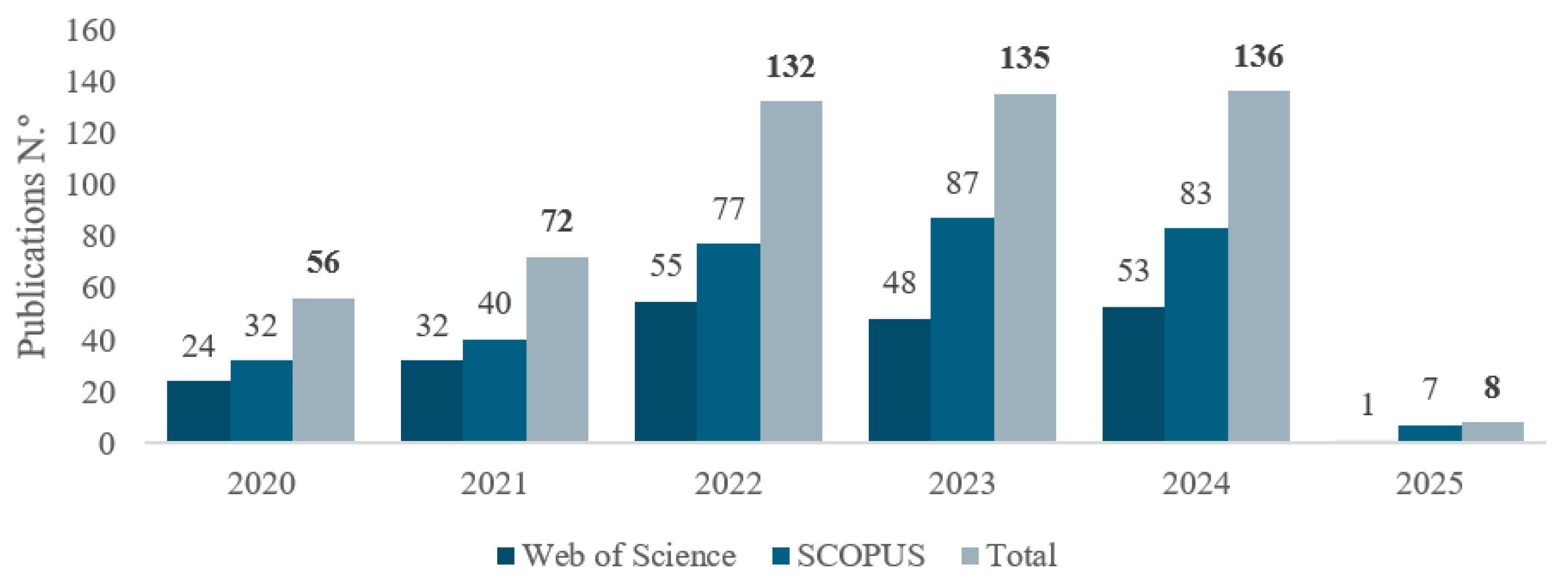
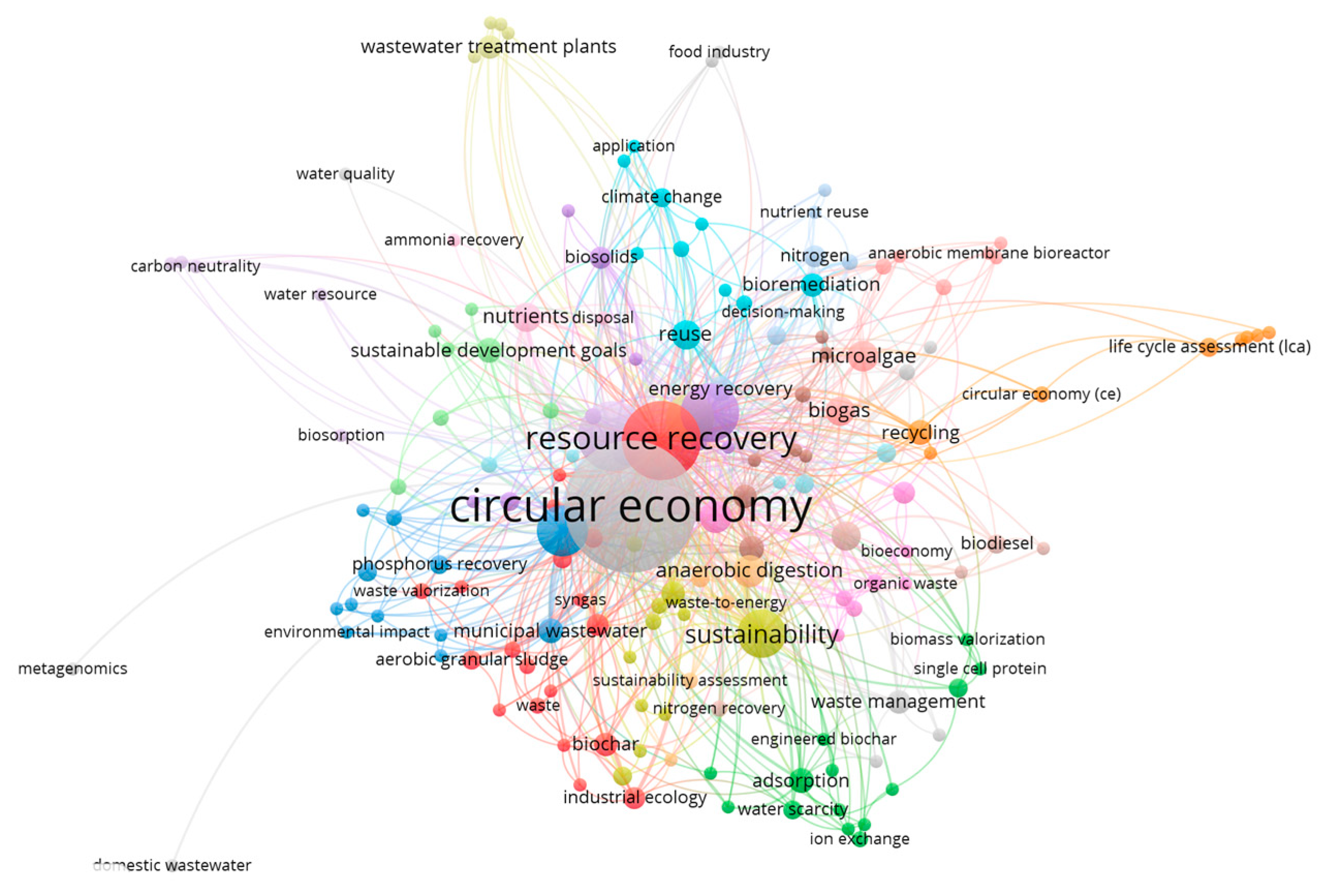
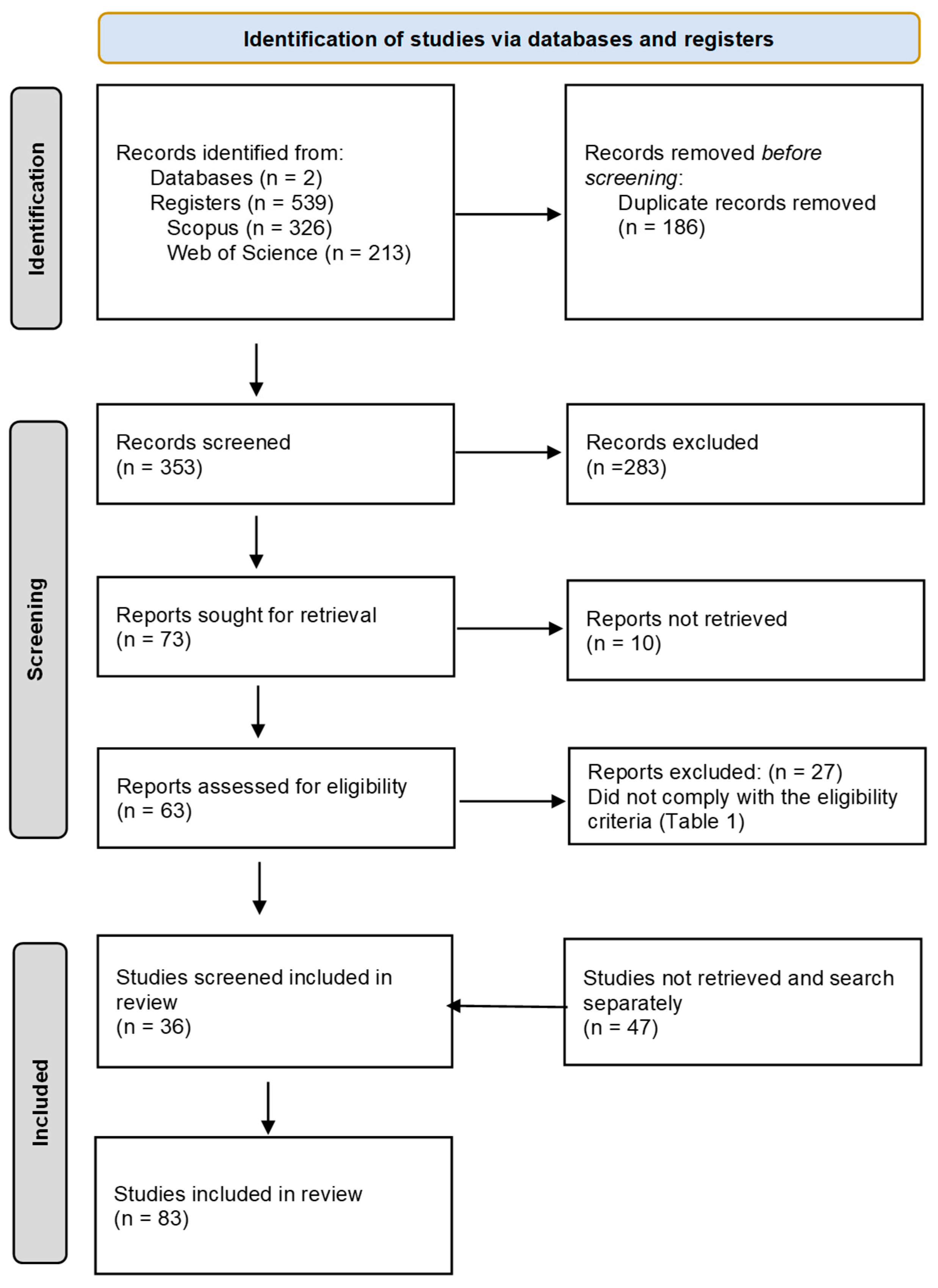
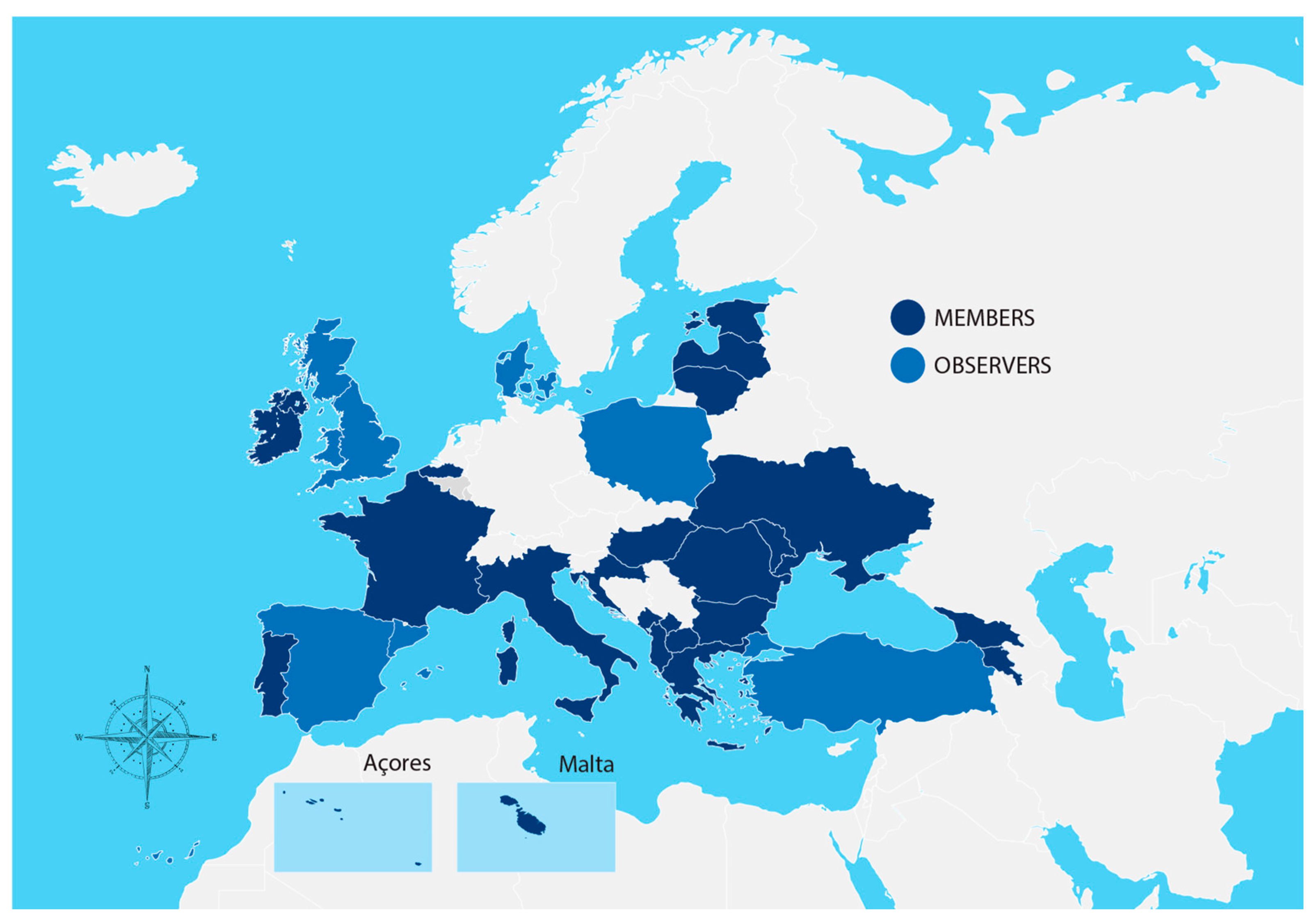

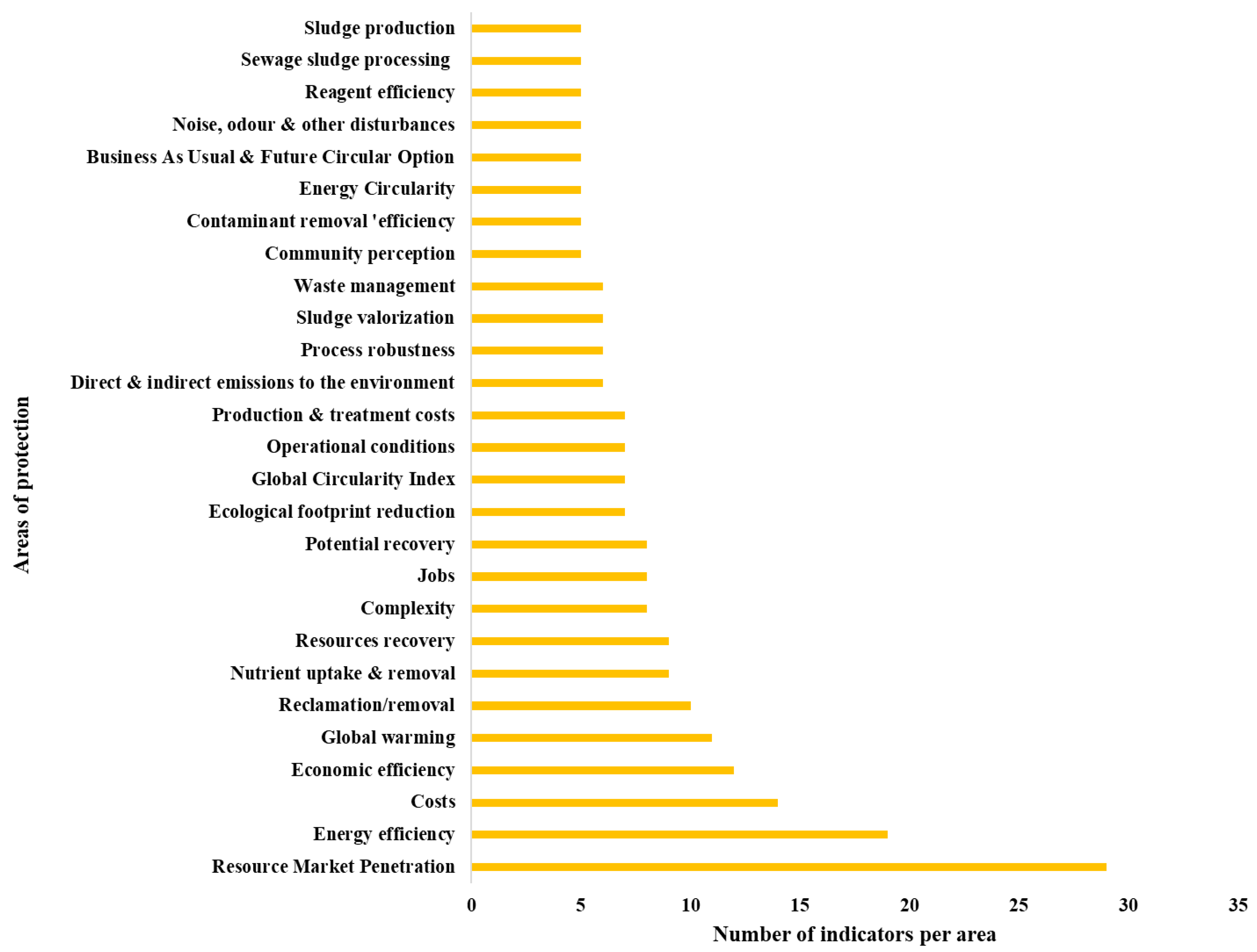
| Research Question | ||
| Are there KPIs that can assess the potential of the wastewater sector’s transition from a linear to a circular model? | ||
| Eligibility Criteria | ||
| ||
| Specified search terms | Web of Science search records | SCOPUS search records |
| The selection of the articles was conducted based on the following identified query: (Topic): “circular economy” and “ wastewater treatment” and “key performance indicators” or “assessment” or “sustainable development” or “resource recovery”; (Publication Year): 2020 or 2021 or 2022 or 2023 or 2024 or 2025; (Document Types): Book Chapters or Article or Review Article; (Languages): English; (Open Access): All Open Access. The results of this step of research are presented in Figure 2. | N = 213 | N = 326 |
| R Strategy | Sustainable Dimension | ||||
|---|---|---|---|---|---|
| Economical | Environmental | Social | Technical | Total | |
| Recovery | 38 | 58 | 5 | 36 | 137 |
| Recycle | 7 | 6 | 6 | 5 | 24 |
| Reduce | 25 | 40 | 23 | 78 | 166 |
| Reuse | 24 | 11 | 9 | 15 | 59 |
| Total | 94 | 115 | 43 | 134 | 386 |
Disclaimer/Publisher’s Note: The statements, opinions and data contained in all publications are solely those of the individual author(s) and contributor(s) and not of MDPI and/or the editor(s). MDPI and/or the editor(s) disclaim responsibility for any injury to people or property resulting from any ideas, methods, instructions or products referred to in the content. |
© 2025 by the authors. Licensee MDPI, Basel, Switzerland. This article is an open access article distributed under the terms and conditions of the Creative Commons Attribution (CC BY) license (https://creativecommons.org/licenses/by/4.0/).
Share and Cite
Rodrigues, C.; Martins, T.A.E.; Amaral, L. From Efficiency to Circularity in the Wastewater Sector: A Review of Performance Indicators in Regulated Countries. Water 2025, 17, 2226. https://doi.org/10.3390/w17152226
Rodrigues C, Martins TAE, Amaral L. From Efficiency to Circularity in the Wastewater Sector: A Review of Performance Indicators in Regulated Countries. Water. 2025; 17(15):2226. https://doi.org/10.3390/w17152226
Chicago/Turabian StyleRodrigues, Carlos, Tiago A. E. Martins, and Leonor Amaral. 2025. "From Efficiency to Circularity in the Wastewater Sector: A Review of Performance Indicators in Regulated Countries" Water 17, no. 15: 2226. https://doi.org/10.3390/w17152226
APA StyleRodrigues, C., Martins, T. A. E., & Amaral, L. (2025). From Efficiency to Circularity in the Wastewater Sector: A Review of Performance Indicators in Regulated Countries. Water, 17(15), 2226. https://doi.org/10.3390/w17152226








